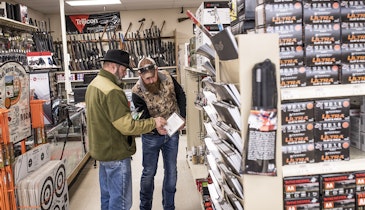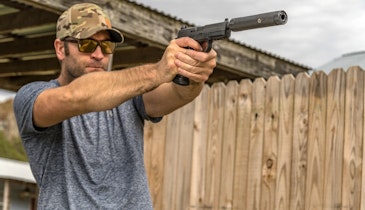Newer competitive shooting sports like 3-gun are spreading like wildfire. While competition shooting has been popular within the shooting community for decades, it’s now becoming mainstream enough to get non-shooters interested in taking up shooting.
According to the Internet, we don’t know exactly how many people are shooting competitively. We know it’s hot, especially 3-gun. And the interest in 3-gun is getting people to take new looks at the more established competitive disciplines like action pistol, defensive pistol, Steel Challenge and Cowboy Action Shooting.
Even with all the interest, I rarely see any type of gear available in local retail stores. Sure, some disciplines like Cowboy Action Shooting are tough to serve locally, as the equipment is so unique, but other sports like 3-gun and action pistol shooting have quite a bit of crossover in accessory gear. As a result, it can be feasible and profitable to stock carefully selected gear. A few product lines can go a long way.
What Are The Sports?
While there are literally dozens of competitive shooting sports covering the gamut from clay targets to air gun bullseye shooting, it doesn’t make sense to try to serve them all. After all, you’ve got to generate enough sales volume to justify an investment in inventory and floor space, and many shooting sports are just too specialized and don’t have enough of a following in any given geographic area.
Here are the most popular right now where a high degree of equipment crossover is realistic.
3-Gun (www.3GunNation.com)
3-gun is on fire because it combines the use of multiple types of guns (three), fast movement and a lot of shooting. It’s an exhilarating sport. Competitors navigate through various stages, making use of handguns, shotguns and modern sporting rifles. Like any sport, plenty of folks immediately make it an equipment race, but new competitors can start with everyday household guns.
USPSA Action Pistol (www.uspsa.org)
The Unites States Practical Shooting Association is part of the International Practical Shooting Confederation. While there are subtle rules and procedural differences between USPSA and IPSC, the general idea is the same. Both have lots of handgun shooting, lots of targets and plenty of movement. Many refer to these action pistol sports as “run and gun.” It’s fast moving and exciting, and you’ll see plenty of tricked-out race guns. There are divisions for standard equipment too, so competitors don’t need to spend thousands on fancy guns and gear to get started.
Steel Challenge (www.steelchallenge.com)
Steel Challenge is fast, but arguably the least intimidating of the action shooting sports for new competitors. There is minimal movement, and people shoot at stationary steel plate targets directly in front of their position. The volume of shooting is high, as each competitor runs through each stage multiple times, so they’ll burn plenty of ammunition. Part of the reason it’s attractive to newer shooters is the satisfaction of hearing steel ring when hit. Steel Challenge provides a fair degree of instant gratification.
IDPA (www.idpa.com)
International Defensive Pistol shooting aims to provide a form of self-defense encounter simulation. Only stock guns are allowed, and in almost all matches, guns must be drawn from concealed positions. Some of the stage scenarios are admittedly unrealistic, but that’s part of what makes the sport appealing. While it’s not as fast-moving as USPSA, competitors still make their way through a course of fire, hitting “bad” targets while avoiding “innocent” ones. It’s a lot of fun. While there’s not as much equipment overlap as with the other disciplines, common items like holsters and magazine carriers can be used in any of these.
Cowboy Action Shooting (www.sassnet.com)
The Single Action Shooting Society has brought back the Old West. Competitors use single-action revolvers, double-barrel or pump shotguns and lever-action rifles to compete in replicated scenarios of actual Old West events. A unique flavor is the requirement to adopt an old western alias — like “Tombstone Tom,” for example — and dress the part of your character. Check your local area for Cowboy Action matches, you might just be surprised at how many folks participate on a regular basis. Obviously, the merchandise you might carry for Cowboy competitors won’t overlap with the action pistol sports.
Sizing The Market Opportunity
Evaluating your potential market can be fairly easy. Choose a radius surrounding your store that makes sense for you. I would suggest 100 miles. That sounds like a lot, but competitive shooters generally have to drive to get to matches, and it’s not uncommon to meet folks who spent two hours making their way a local match.
Next, check the websites of the competitive shooting organizations mentioned here. All of them have match schedules and locations listed, so you can easily learn more about how much activity is within your area of interest. You can scan competition results, also posted, to get an idea of how many people participate in each match, but I would recommend going to several to see for yourself. Heck, why not enter a competition or two and have some fun? You might be able to write off the expenses as market research!
Don’t stop here, though. Not all local competitive activity is posted on the national sites. Check the National Shooting Sports Foundation’s Where To Shoot website (www.wheretoshoot.org) to find the shooting ranges and clubs in your area. Give them a call or check their websites for match information. You might find additional competitions including rifle or bullseye pistol, local 3-gun matches, or others.
What To Stock
Deciding how to optimize your inventory can be less tricky than it sounds. While competitive shooting is certainly specialized in terms of equipment needs, there is quite a bit of crossover with the accessories shooters need.
For any of the action sports, like 3-gun, Steel Challenge, and USPSA action pistol, everyone will need a competition shooting belt, holster and various types of magazine carriers. There are several competition belt systems on the market, and each has a variety of compatible holsters and magazine holders that can be positioned according to user preference. Better yet, the systems are modular and can be easily reconfigured for different competitive needs. For 3-gun, add some AR magazine holders and shotgun shell holders. For Steel Challenge, just remove those and load up with handgun magazine carriers. Most of the competition belt systems feature a two-part construction. An inner belt goes through pants belt loops and has outward-facing hook and loop material. A firm outer belt attaches via the hook and loop. It’s simpler than it sounds.
Check out the Safariland Competition ELS belt system. The outer belt is extremely rigid and covered with a pattern of holes. Special ELS-compatible gear clamps on and off easily, and there’s a huge selection of magazine carriers, revolver speed loader holders and various types of shotgun shell and rifle magazine holders. It’s an incredibly versatile system.
More traditional competition belt options are available from Blade-Tech, Double-Alpha and Hogue. These are still two-part belt systems, but the outer belt is traditional in design. You simply hang standard belt accessories of any kind using belt loops on the gear.
The beauty of these systems is that you can get away with carrying one brand to get started. If you know competition is big in your area and you want to go after that market, consider picking up the Safariland ELS system. It’s got everything a competitive shooter needs, and the modular nature allows shooters to buy bits and pieces forever.
In addition to the gear required for competition itself, consider adding practice accessories. The good thing is that this type of gear isn’t specific to just competitive shooters. Anyone who owns a gun can benefit from the ability to practice at home.
Recently, I’ve been experimenting with LaserLyte targets. These are brilliant inventions that actually make dry-fire practice fun. The company makes blue plastic laser guns, but the most interesting options for competitive and self-defense shooters are the Laser Trainer Cartridges. These brass dry-fire “snap caps” contain tiny batteries and a built-in laser. Unload your actual gun, insert the Laser Trainer Cartridge, and you’re ready to go. When the firing pin strikes the cartridge, a laser beam fires through the muzzle of your gun. A variety of targets provide visible and audible feedback on your accuracy and speed. I particularly like the Reaction Tyme Laser Targets. These have a random mode that prompts you to draw, fire and obtain a hit within a couple of seconds. It adds a whole new dimension to dry-fire practice at home.
Promotion
Rather than spending money to bring competitive shooters to your store, you might consider meeting them where they live. The easiest and most effective way to do that is to get involved in local matches. Every match director is in constant need of target holders, steel plates and wood uprights. You might consider donating some gear in return for signage. A banner for the clubhouse and check-in area is a good start, but you might be able to get more creative. Why not create semi-disposable signs and mount them on the target stands? If you put them down low, well below the target, they’ll be visible to every single shooter throughout the match.
Many local clubs have active youth shooting teams, and they want to gear up like the pros. You might consider donating money, ammunition, a team gun or accessory gear in return for logo exposure on the team shirts. If you really want to get noticed, you can provide the shirts based on your own design. All the pro shooters proudly display sponsor logos on their uniforms; why not do the same thing for the youth teams? Little League baseball teams have been following that model forever.
Another idea is to sponsor the safe area stations. Most every match has safe areas where shooters can handle their guns with no ammunition present. Work with the match director to develop a safety rules sign and put your logo and message on it. It’s yet another location that every shooter will see over and over again.
Get creative and steal signage and sponsorship ideas from other industries.
There’s a learning curve for new competitive shooters, and online education doesn’t help them much. If you consider learning the ropes of your local competitive events and make some basic stock investments, you can become the trusted local resource. Wouldn’t it be great if local match directors referred new shooters to your store to get everything they need?






